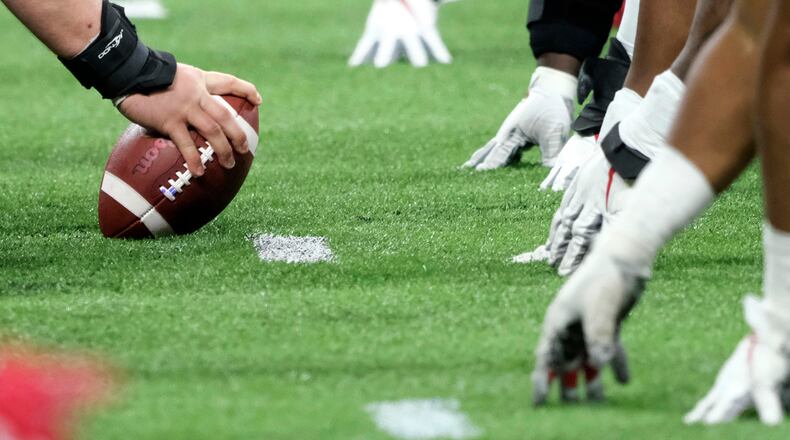Myocarditis, or inflammation of the heart muscle, is one form of associated cardiac injury that can be linked to COVID-19.
The rare heart condition usually occurs because of a viral infection, and according to ESPN, it has been found “in at least five Big Ten Conference athletes and among several other athletes in other conferences,” and has become a major concern in the debate on whether it’s safe for college athletics to take place in the fall.
The Big Ten and Pac-12 have canceled their football seasons for the fall, reportedly with an eye on playing in the spring, but the SEC, ACC and Big 12 have yet to do so.
On Thursday, Dr. Jonathan Kim, the chief of sports cardiology at Emory University, further explained the details of myocarditis. Kim is also an assistant professor of cardiology at Emory University School of Medicine and a member of the ACC Sports and Exercise Council.
In looking at hospitalized patients with COVID-19, a high degree of associated cardiac injury was found, roughly around 20 percent, according to Kim, whether that entails myocarditis, worsened heart function, arrhythmia or other issues.
“Maybe around 1 percent of the time you’ll see this kind of cardiac injury (resulting from other viral infections), but with COVID-19, a much higher degree,” Kim said.
However, that hospitalized population largely is not made up of the younger, healthier people who would be playing college sports and college football. Kim emphasized the need to collect more data on this.
“How much myocarditis is there with COVID-19 in athletes, we don’t have the answer right now, and that will hopefully be a part of some of the data that we are hopeful to accrue and report on in the future, in the near future,” Kim said.
“... We on the scientific side on sports cardiology, we need to look at the data. And so I do believe at all levels, from the professional level to the collegiate level, all of these data with athletes that are being screened, we’re going to be able to look at and to analyze and to make decisions. Now, of course it takes a lot of effort in terms of leveraging all the data into a registry, and we’re in the process, a lot of people are in the process, of trying to do just that. We all recognize that it is going to be very important.
“So certainly my role with the American College of Cardiology, we are trying to do that, and we anticipate that we will, and the data are going to be extremely important to help guide this.”
Kim did not take a stance on whether sports should ultimately return to play, believing that to be more of a public health issue that relies on national experts and their recommendations based on the rate of community spread in different areas. That is a little different from the specific cardiac concerns, Kim said, and the downstream concerns stemming from COVID-19, including those affecting the heart.
“I don’t think that my field, per se, the sports cardiology aspect should guide the question of should sports be played right now, or should high school, college athletes be coming back to play,” Kim said. “I still think it really is more of a public-health concern and question for them. We are a part of that discussion, but as we’ve all learned over the last several months, it’s really all about controlling the viral spread. That’s what’s most important.”
The severity of myocarditis, per Kim, can vary greatly. It can be subclinical, with people not even knowing they have it, to severe.
If someone has myocarditis and is actively intensely training, engaging in intense physical activity (on par with that of college athletes), that can make the inflammation worse and can potentially bring on dangerous heart rhythms, which can lead to cardiac arrest.
“We don’t quite know the overall incidents of myocarditis in the general population, but is estimated to be relatively rare in the general population,” Kim said. “Now for athletes, in opposite to that, we know that myocarditis is a more sudden cause of cardiac arrest or sudden cardiac death in athletes and these data come from various registries looking at sudden death in athletes over the years. So it is certainly something that we take very seriously in athletic patients.”
If myocarditis is found in a patient, Kim advocates for a conservative approach to treatment.
“What we recommend is, at a minimum, three months of no high-end physical training,” Kim said. “The recommendation is rest. At a minimum three months, up to six months. And at that time, based on the clinical presentation, the athlete would undergo a series of repeat testing, which would include imaging, exercise testing, Holter monitoring to look at the heart rhythm, potentially other tests, and if all those tests are normal, then the athlete would be allowed back to return to play.”
Overall, Kim thinks athletes should have the freedom to decide whether they want to participate in sports, given the health risks.
“I think this is a very individualized decision, as it relates to the athlete and the athlete’s family,” Kim said. “My role in what I’ve tried to do as much as possible with athletes that I take care of when they ask this question, is just to provide the education. Let them know what them know, what we don’t know. Hopefully they’re getting the same information from a public-health expert. … I think if an athlete were to choose not to participate for whatever the reason may be, and if it includes some of the potential unknown cardiac concerns, I would respect that decision.”
About the Author
Keep Reading
The Latest
Featured

